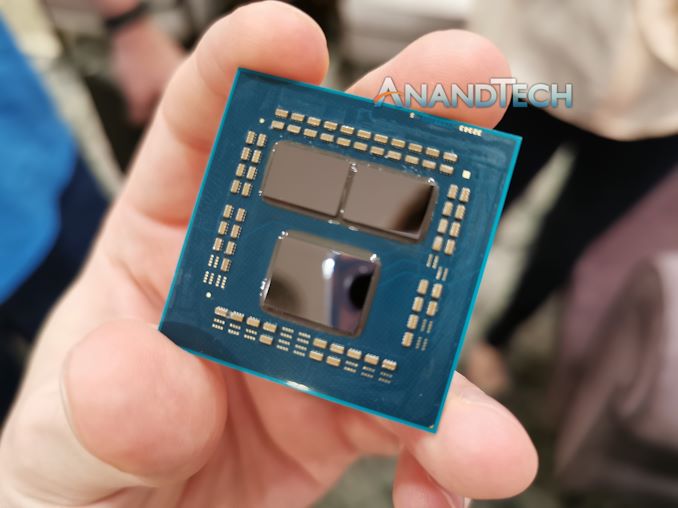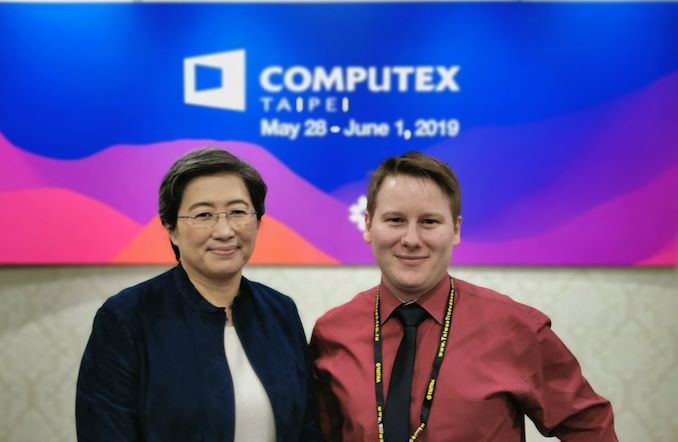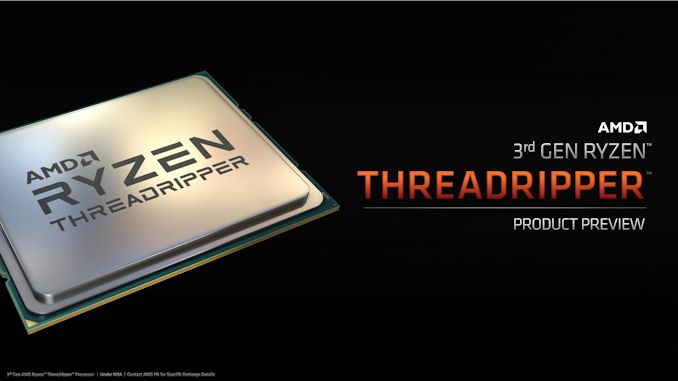AMD Q4: 16-core Ryzen 9 3950X, Threadripper Up To 32-Core 3970X, Coming November 25th
by Dr. Ian Cutress on November 7, 2019 9:00 AM EST
AMD is set to close out the year on a high note. As promised, the company will be delivering its latest 16-core Ryzen 9 3950X processor, built with two 7nm TSMC chiplets, to the consumer platform for $749. Not only this, but AMD today has lifted the covers on its next generation Threadripper platform, which includes Zen 2-based chiplets, a new socket, and an astounding 4x increase in CPU-to-chipset bandwidth.
This year AMD is presenting its ‘Fall 2019 Desktop Update’, covering the new products for the holiday season. Q4 is historically a good target for increased consumer sales, as long as the products hit the right price point and are available in volume for the peak shopping periods. We’ve been waiting mercilessly for more details about the crème-de-la-crème of what AMD has to offer with its 7nm product portfolio for both mainstream Ryzen desktop processors, but also the creator and workstation focused 3rd Gen Threadripper. After continuously requesting information from CEO Lisa Su since the middle of the year, AMD is lifting the lid on the product details, pricing, and launch dates.
The short version of today’s announcement revolves around several parts, in completely different markets.
- The Ryzen 9 3950X 16-core CPU for desktops
- Ryzen Threadripper 3rd Gen Family: Starting with the 24-core 3960X and 32-core 3970X
- New TRX40 motherboards for the new Threadripper Processors
- A new $49 Athlon 3000G for the entry level market
All of this hardware is set to come to market through the month of November at the following dates:
- Ryzen 9 3950X: Retail on November 25
- TR 3960X and TR 3970X on November 25th
- TRX40 motherboards on November 25th
- Athlon 3000G on November 19th
One key takeaway from today’s announcements is how AMD is moving the traditional desktop and high-end desktop markets. When CEO Dr. Lisa Su was asked earlier this year what will happen to Threadripper as the mainstream Ryzen family moves ‘up’ in performance, her response was that ‘Threadripper will move up-up’. To that effect, we are seeing AMD’s delineation between mainstream desktop and high-end desktop move up to between 16-core and 24-core, with room at the top for more cores if AMD wants to go that way.

Our Group Interview with Dr. Lisa Su at Computex 2019
This new hardware is also breaking new records for enthusiast CPU TDP values, as well as representing new ground on the latest 7nm process technology now available to the wider market. Details about pricing, TDP, AMD’s strategy, AMD’s performance numbers, TRX40 chipset information, and analysis of the announcements are all inside.












171 Comments
View All Comments
evernessince - Thursday, November 7, 2019 - link
It's a HEDT processor, it's designed for professionals. If it speeds up your work then that for many is worth a lot of money.Irata - Friday, November 8, 2019 - link
That's why I said "considerable part of buyers". I am sure that for professionals it is more than worth it.For someone like me, however, it would definitely be a "want" CPU - as far as my needs / use cases go, a 3700x or even 3600 would be perfectly fine, however I want a 3950x because it is what it is.
The cool thing is that I can get a lower end Ryzen 3000 now (with a good main board) and upgrade to the 3950x later when it is offered at EOL prices.
Spunjji - Friday, November 8, 2019 - link
One thing I like about the 3950X is that it's blurring the lines of what HEDT is, in a good way. Availability of this many cores on a mainstream desktop platform is a great incentive for developers to look for ways to use that power.As Irata points out - your common-or-garden end user can purchase a 4, 6 or 8-core system and then eventually upgrade to 3950X at a (potentially much) later date when more software benefits. There's already been an uptick in software like games using meaningfully more cores since Zen first released; I'd anticipate that trend continuing, albeit acknowledging the difficulty of multi-core scaling for many tasks means the trend will likely slow down.
MASSAMKULABOX - Monday, November 11, 2019 - link
yep anything above 6 cores is gonna sit around doing nothing most of the time , for ordinary users. And ven for other users multi-cores are very under utilized... they have run out of ideas to make us upgrade, datacentres need it and HPC need it but home users? no way .. E-peen ?b.ritesManch - Thursday, November 7, 2019 - link
TR is mainly for content creation and other things where more cores is beneficial. If games and browsers are your thing, just get a Zen 3 or Intel equiv. No point in spending on this.haukionkannel - Friday, November 8, 2019 - link
Yep... 3600 or 3700 Are for Gaming. Anything above more to content creation!Targon - Thursday, November 7, 2019 - link
A game like Kingdom Come: Deliverance shows that performance can drag with a lower number of CPU cores, but I don't know how well it scales up. I would expect that similar games with a lot of AI controlled NPCs would see a big benefit from additional CPU cores if the game is designed to use them.SeannyB - Thursday, November 7, 2019 - link
TR 1950X user here. In general use, it's great at multitasking. You can be doing a lot of things at once and the system doesn't choke because there are always more cores. And the rare case (certain kinds of content creation) where a single program can utilize all cores, it's ludicrously faster than the 6-core Ivy Bridge "Extreme" I had prior. TR + fast storage + 32GB RAM is a dream machine for PC desktop, IMO.As far as gaming goes, benchmarks tell the story. Game engines that can multi-thread draw calls running content that is mostly limited by draw calls see the most benefit, but even then it won't beat a fast Intel; TR will keep pace at best. Off-the-shelf game engines like Unity & Unreal run all of their game logic & world/physics simulation on one or two threads, so simulation games using those engines like Cities Skylines and Kerbal Space Program are ultimately CPU frequency-limited because the bottleneck lies in their gamesim/physics thread.
surt - Thursday, November 7, 2019 - link
If you have reason to buy TR, you should really be buying no less than 64G to pair it with.SeannyB - Thursday, November 7, 2019 - link
In 2017, 64GB seemed like overkill for a 16-core system. Even now, I never top out even as I'm running Unreal Engine (editor), 3DS Max, Ableton Live even simultaneously... Of course, YMMV. 16-core soon enough will merely be a top-end Ryzen, and 24-core & up is a decidedly different class of computer, and I suppose 64GB is appropriate for that.